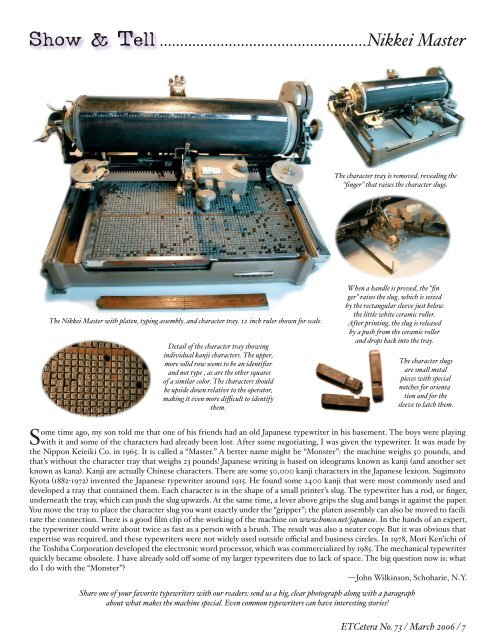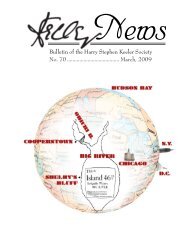John Newton Williams: The Untold Story - Personal Web Sites are ...
John Newton Williams: The Untold Story - Personal Web Sites are ...
John Newton Williams: The Untold Story - Personal Web Sites are ...
You also want an ePaper? Increase the reach of your titles
YUMPU automatically turns print PDFs into web optimized ePapers that Google loves.
Show & Tell ...................................................Nikkei Master<br />
<strong>The</strong> Nikkei Master with platen, typing assembly, and character tray. 1 -inch ruler shown for scale.<br />
Detail of the character tray showing<br />
individual kanji characters. <strong>The</strong> upper,<br />
more solid row seems to be an identifier<br />
(and not type), as <strong>are</strong> the other squ<strong>are</strong>s<br />
of a similar color. <strong>The</strong> characters should<br />
be upside down relative to the operator,<br />
making it even more difficult to identify<br />
them.<br />
<strong>The</strong> character tray is removed, revealing the<br />
“finger” that raises the character slugs.<br />
When a handle is pressed, the “finger”<br />
raises the slug, which is seized<br />
by the rectangular sleeve just below<br />
the little white ceramic roller.<br />
After printing, the slug is released<br />
by a push from the ceramic roller<br />
and drops back into the tray.<br />
Some time ago, my son told me that one of his friends had an old Japanese typewriter in his basement. <strong>The</strong> boys were playing<br />
with it and some of the characters had already been lost. After some negotiating, I was given the typewriter. It was made by<br />
the Nippon Keieiki Co. in 1965. It is called a “Master.” A better name might be “Monster”: the machine weighs 50 pounds, and<br />
that’s without the character tray that weighs 23 pounds! Japanese writing is based on ideograms known as kanji (and another set<br />
known as kana). Kanji <strong>are</strong> actually Chinese characters. <strong>The</strong>re <strong>are</strong> some 50,000 kanji characters in the Japanese lexicon. Sugimoto<br />
Kyota (1882-1972) invented the Japanese typewriter around 1915. He found some 2400 kanji that were most commonly used and<br />
developed a tray that contained them. Each character is in the shape of a small printer’s slug. <strong>The</strong> typewriter has a rod, or finger,<br />
underneath the tray, which can push the slug upwards. At the same time, a lever above grips the slug and bangs it against the paper.<br />
You move the tray to place the character slug you want exactly under the “gripper”; the platen assembly can also be moved to facili�<br />
tate the connection. <strong>The</strong>re is a good film clip of the working of the machine on www.honco.net/japanese. In the hands of an expert,<br />
the typewriter could write about twice as fast as a person with a brush. <strong>The</strong> result was also a neater copy. But it was obvious that<br />
expertise was required, and these typewriters were not widely used outside official and business circles. In 1978, Mori Ken’ichi of<br />
the Toshiba Corporation developed the electronic word processor, which was commercialized by 1985. <strong>The</strong> mechanical typewriter<br />
quickly became obsolete. I have already sold off some of my larger typewriters due to lack of space. <strong>The</strong> big question now is: what<br />
do I do with the “Monster”?<br />
—<strong>John</strong> Wilkinson, Schoharie, N.Y.<br />
Sh<strong>are</strong> one of your favorite typewriters with our readers: send us a big, clear photograph along with a paragraph<br />
about what makes the machine special. Even common typewriters can have interesting stories!<br />
<strong>The</strong> character slugs<br />
<strong>are</strong> small metal<br />
pieces with special<br />
notches for orientation<br />
and for the<br />
sleeve to latch them.<br />
ETCetera No. 73 / March 006 / 7





